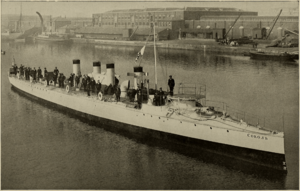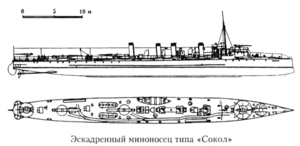Russian destroyer Sokol (1895) facts for kids
class="infobox " style="float: right; clear: right; width: 315px; border-spacing: 2px; text-align: left; font-size: 90%;" |+Sokol
| colspan="2" style="text-align: center; font-size: 90%; line-height: 1.5em;" | 
|}
The Sokol (which means "Falcon" in Russian) was a very important ship. It was the first "torpedo boat destroyer" ever built for the Imperial Russian Navy. This type of ship was designed to be super fast and carry powerful torpedoes.
A British company called Yarrows built Sokol between 1894 and 1895. When it was tested, it was said to be the fastest warship in the whole world! In 1902, its name was changed to Pruitki (meaning "Nimble").
This destroyer was part of Russia's Baltic Fleet. It played a role in the First World War. Later, after the October Revolution, its crew joined the Bolsheviks and the ship became part of the Red Fleet. Pruitki was also active during the Russian Civil War before it was taken apart for scrap metal in 1922.
Contents
| History | |
|---|---|
| Name | Sokol (1895–1902) Pruitki (1902–1917) |
| Builder | Yarrow, Poplar, London |
| Laid down | November 1894 |
| Launched | 22 August 1895 |
| Fate | Joined the Bolsheviks, November 1917 |
| Name | Pruitki |
| Acquired | November 1917 |
| Fate | Scrapped 1922 |
| General characteristics | |
| Displacement | 220–240 long tons (220–240 t) |
| Length | 57.91 m (190 ft 0 in) |
| Beam | 5.64 m (18 ft 6 in) |
| Draught | 2.29 m (7 ft 6 in) |
| Installed power | 2,900 ihp (2,200 kW) |
| Propulsion |
|
| Speed | 29 knots (54 km/h; 33 mph) |
| Armament |
|
Building a Super Fast Ship
After the British Royal Navy, the Imperial Russian Navy was the next to order these new destroyer ships. They chose Yarrow & Company, a British company famous for building fast torpedo boats. Yarrow had already built some of the Royal Navy's first destroyers.
Sokol's design was similar to the British destroyers. But it used special materials to make it lighter and faster. Its body was made with a lot of nickel steel. Some parts were even made from aluminium to save weight.
Sokol's Size and Power
The ship was about 57.91 m (190 ft 0 in) long, which is like putting five school buses end-to-end. It was 5.64 m (18 ft 6 in) wide and sat 2.29 m (7 ft 6 in) deep in the water. The ship weighed between 220–240 long tons (220–240 t).
To make it go fast, Sokol had two powerful steam engines. Eight special Yarrow boilers heated water to create steam. This power made the ship move at an amazing 29 knots (53.7 km/h; 33.4 mph).
Weapons on Board
Sokol was armed with several weapons. It had one large 75 mm gun on top of its control tower. It also had three smaller 47 mm guns.
For attacking other ships, it carried two 381 mm (15 in) torpedo tubes. These tubes could launch up to six torpedoes. The ship could also carry ten mines, which are underwater bombs. A crew of 54 officers and sailors operated the ship.
First Tests and Speed Records
Sokol was started in November 1894. It was launched into the water on August 22, 1895, at Yarrow's shipyard in Poplar, London. All its engines were already installed! This meant it could start its first tests the very next day.
During these tests, Sokol reached a speed of 30.285 knots (56.1 km/h; 34.9 mph). In its official trials, it hit 30.28 knots (56.1 km/h; 34.8 mph). These speeds made people say Sokol was the fastest warship in the world!
Because Sokol was so good, Russia built 31 more destroyers like it. They were built in Russian shipyards from 1896 to 1908. However, none of these later ships could quite match Sokol's amazing speed.
Sokol's Service History
Sokol officially joined the navy in October 1895. It sailed to the Russian port of Kronstadt that same month and became part of the Russian Baltic Fleet. On March 22, 1902, the ship was renamed Pruitki.
Experiments and Upgrades
From 1902 to 1903, Pruitki was used for interesting experiments. They tested using man-lifting kites from the ship. These kites could carry observers high up or help with weather observations.
The ship had a big upgrade between 1909 and 1910. Based on lessons learned from the Russo-Japanese War, its weapons were changed. A second 75 mm gun replaced the three smaller 47 mm guns. The old torpedo tubes were also replaced with larger 457 mm (18 in) tubes.
World War I and Beyond
By August 1914, when the First World War began, Pruitki was considered an older ship. It wasn't really suited for front-line fighting anymore. So, in 1915, it was changed to become a minesweeper. This meant it would clear dangerous underwater mines.
During the war, Pruitki helped clear mines, patrolled the waters, escorted other ships, and carried messages in the Gulf of Finland and Gulf of Bothnia. In January 1916, it joined the 2nd Minesweeping Division.
Russian Revolution and Civil War
After the October Revolution, Pruitki's crew decided to support the Bolsheviks. The ship then became part of the Red Fleet. In March 1918, Germany sent troops to help the Finnish White forces in the Finnish Civil War. The German and White Finnish forces started moving towards Helsingfors (now Helsinki), where the Baltic Fleet was located.
On April 10, 1918, the Bolsheviks managed to move most of the Baltic Fleet, including Pruitki, away from the danger. This was difficult because much of the Baltic Sea was still frozen. Pruitki arrived at Kronstadt on April 19. The journey took ten days, even though it normally took only half a day. This shows how hard it was to sail through the ice with small ships.
In August 1918, during the Russian Civil War, Pruitki and other ships were moved from Petrograd to the River Volga. They traveled through the Mariinsk Canal System, reaching Nizhny Novgorod on August 24.
From August to October 1918, Pruitki fought against White Army forces near Kazan and on the River Kama. Later, it moved to the lower parts of the Volga River and operated in the northern Caspian Sea from 1919 to 1920. The ship was officially removed from service on August 16, 1922, and then taken apart for scrap.
See also
- List of destroyers of the Imperial Russian Navy


